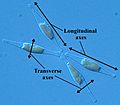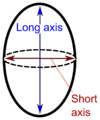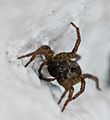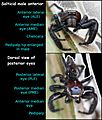Ventral facts for kids
Ventral is a word used in biology to describe the underside or belly side of an animal. Think of it as the side that usually faces the ground when an animal is standing or moving.
For example, in many invertebrates (animals without a backbone, like worms or insects), their nerve cord (which is like their brain and spinal cord) runs along their ventral side, underneath their gut.
The opposite of ventral is dorsal, which means the upper side or back of an animal. So, if ventral is the belly, dorsal is the back!
These terms help scientists and vets describe exactly where something is on an animal's body, no matter how the animal is positioned.
Contents
Understanding Ventral and Dorsal
Imagine a dog. Its belly and chest are on its ventral side. Its back, where its fur is, is on its dorsal side. These terms are super useful because they always mean the same thing, even if the animal is upside down or lying on its side.
Why These Terms Are Important
Scientists use words like ventral and dorsal to be very clear when they talk about animal bodies. It's like giving directions on a map. If you say "the spot on the ventral side," everyone knows exactly where you mean, whether it's a tiny insect or a huge whale. This helps them study animals, understand how their bodies work, and even help them when they are sick.
Examples in Different Animals
- Fish: The belly of a fish is its ventral side. Its back, where the dorsal fin often is, is its dorsal side.
- Humans: For humans, our chest and stomach are on our ventral side. Our back is our dorsal side.
- Insects: If you look at a beetle, its legs are on its ventral side, and its hard shell is on its dorsal side.
Images for kids
-
Because of differences in the way humans and other animals are structured, different terms are used according to the neuraxis and whether an animal is a vertebrate or invertebrate.
-
Anatomical terms can be combined to be more specific. This is a dorsolateral view of the frog Mantophryne insignis.
-
Terms can be modified with prefixes and suffixes. In this image showing the jellyfish species Chrysaora, the prefix 'ab-', is used to indicate something that is 'away from' the mouth, for example the aboral. Other terms are combined to indicate axes, such as proximodistal axis.
-
Four individuals of Phaeodactylum tricornutum, a diatom with a fixed elongated shape.
-
Anatomical axes and directions in a fish
-
Spheroid or near-spheroid organs may be measured by "long" and "short" axis.
-
Anatomical terms of location in a dog
-
Anatomical terms of location in a fish.
-
Anatomical terms of location in a horse.
-
Aurelia aurita, another species of jellyfish, showing multiple radial and medio-peripheral axes
-
The sea star Porania pulvillus, aboral and oral surfaces
-
Aspects of spider anatomy; This aspect shows the mainly prolateral surface of the anterior femora, plus the typical horizontal eye pattern of the Sparassidae
-
Typical arrangement of eyes in the Lycosidae, with PME being the largest
-
In the Salticidae the AME are the largest

















